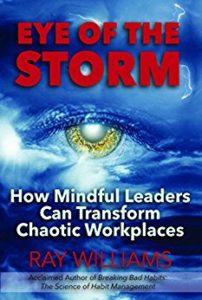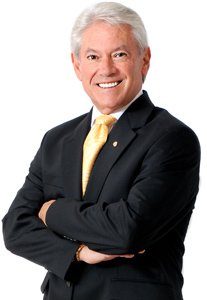Leaders can enhance their effectiveness and develop better relationships with employees by having mindful conversations.
In my new book, Eye of the Storm: How Mindful Leaders Can Transform Chaotic Workplaces I describe how multiple and increasing demands on leaders’ attention can have a negative impact on their performance.
Executives’ calendars are often booked back-to-back all day based on the proposition that it is both necessary and leads to greater productivity, despite the evidence that it doesn’t. The relenting demands on executives’ time can produce what is known as “power stress,” a side effect that leaves the individual physically and emotionally drained. If leaders believe they don’t have the time to work through all aspects of a problem they’re faced with, they are inclined to be narrow in perspective, take cognitive shortcuts, and become more impulsive and reactive. Their actions, in effect, become “mindless,” unconscious and automatic.
Daniel Siegel, a neuroscientist and author of The Mindful Brain: Reflection and Attunement in the Cultivation of Well-Being, contends a corporate culture of cognitive shortcuts results in oversimplification, curtailed curiosity, reliance on ingrained beliefs and the perceptional blind spots.
A research study by Paul McDonald at the University of Wellington’s School of Management argues that today’s leaders have scant time for self-awareness through introspection and personal insight. Christopher Edgar, author of Inner Productivity: A Mindful Path to Efficiency and Enjoyment in Your Work being aware of your inner state—your thoughts and emotions—and learning how to manage and self-regulate the mental “chatter” that interferes with optimal performance, is the greatest challenge for leaders. Being self-aware means we learn how to intentionally respond to experiences in our life instead of reacting to them.

Regular practices of mindfulness can give leaders a different perspective on their world, opening them up to ways of being which are both more focused on what matters and more observant and appreciative of what is there. Paradoxically, becoming more present through mindfulness enables leaders to see reality more clearly and act more purposefully and with less of their own stuff getting in the way. This is one of the paradoxes in mindful leadership: to open up for change, it is necessary to sometimes stop striving to change things and to stop talking and listen; to stop doing and start being.
Research studies have shown that regular mindfulness practices elicit better attentional capabilities and more positive emotional states. Mindfulness trains people to increase their capacity to pay attention (beyond the 3-7 seconds that is normal) and to expand the qualitative aspects of attention. Daniel Goleman, in his book, Focus: The Hidden Driver of Excellence, underscores the importance of leaders maintaining a triple focus, where an inner focus is equally important along with an outer or external focus. Harvard psychologist Ellen Langer advocates leaders developing an “environmental mindfulness”: constant questioning and listening; inquiry, probing, and reflecting; gathering insights and perspectives from other people. This active engagement leads to smarter questions, better learning, and a more sensitive early warning radar to coming changes.
One of the casualties to an overemphasized external focus, filled with multiple meetings and agendas are meaningful and mindful conversations. In my two decades of coaching leaders and their teams, I’ve had the opportunity to observe leaders’ conversational skills in action, and found a wide contrast both in styles and results. The leaders who struggle often appear to be, or actually are, hurried, busy, almost frenetic in “getting things done,” and as a result, their conversations with others reflect these characteristics:
- They come to conversations without actually being “present” in the conversation because their minds are full of thoughts and emotions from a previous conversation or an anticipated one—in short, their minds are either in the past or in the future.
- They exhibit poor listening skills, being more focused on what they want to say.
- They exercise their authority to “control” the conversation to a predetermined outcome.
- They exhibit a close-mindedness to others’ perspectives in the conversation.
- They are in a rush to end the conversation as soon as possible, so they can get on with other or “more important” things.
- They are oblivious or inattentive to the emotional or feeling states of the other people in the conversation.
- They are oblivious or inattentive to their own internal emotional state while they engage in a conversation.
- The net result of these behaviors can be a lack of connection and trust with employees and others and a lack of awareness of their own internal emotional state.
So how can leaders have more mindful conversations to both avoid these unproductive and unappreciated tendencies?
9 tips for having more mindful conversations
- Slow down. Leaders may be concerned about the conversation dragging on too long, or not being able to cover all the items on an agenda, but projecting the energy and feeling of being in a hurry in conversations gives the impression to other speakers that what they have to say, and therefore they, are not important to you. There’s a need to balance results with connection. The key here is internal, not just external. That means slowing down your thoughts and feelings not just your actions.
- Breathe. Often when conversations get intense or heated, participants’ breathing may become shallow, which reduces the oxygen supply to the brain, which in turn, can impair cognitive functioning. Remembering to breathe normally, or deeply when things become intense is an mindful practice.
- Focus your attention. It’s normal for your mind to wander much of the time, including during conversations. That’s why mindfulness meditation can help you learn to focus your attention more fully. If you notice your thoughts wandering while someone else is speaking, just note that, and gently return to the conversation at hand.
- Listen with your heart, not just your head. Listening training tends to emphasize cognitive skills, including such things as paraphrasing. Equally—and even more important—are listening with empathy and compassion. Be sensitive to others’ emotional state while they speak or respond to you. This may also require you to be keenly aware of your own emotional state.
- Be Open and Curious. Leaders can enter conversations with a close-mindedness, and unwillingness to see other perspectives. The mindful practice of “beginner’s mind,” in which the you make no assumptions about what has happened or needs to happen, but rather keeping an open mind, and seek out others’ perspectives in an open way will make the conversation more meaningful. This also requires you to make fewer assertions or speeches and ask more questions.
- Practice acceptance and non-judgment. This doesn’t necessarily agreeing with others’ perspectives or opinions, but it does mean accepting who they are, and what they think and how they feel at face value. It also means accepting the emotions you may be feeling yourself, particularly the negative ones.
- Be present. All to often people in conversations are not fully present. They may be thinking of the response they want to make, or the next conversation they are going to have, or reviewing in their mind past conversations. In either case, they are not really “here” in the present moment, giving their full attention to what is happening.
- Mindfulness can enhance your ability to be and keep present in conversations. One of the most important ways to accomplish this is to turn off all electronic devices (such as smartphones) while you’re having the conversation and give full attention to the conversation at hand.
- Respond to others in a mindful intentional way, rather than reactive way. At times during intense, controversial or difficult conversations the defensive and protective parts of participants’ brains can be unconsciously and automatically be quickly activated resulting in a reactive response which can negatively impact the conversation. Mindfulness can aid the leader through the process of noticing and labeling the emotion that is arising, pausing and creating space for a calm and intentional response.
- Temporarily set aside your personal agenda. Leaders can go into meetings with a predetermined agenda, including what they will say, how they will respond to opposition, and the outcome(s) they want. While this may be desirable in some situations, making it a habit stifles conversations, and makes others reticent to participate in meaningful ways. Being able to temporarily set aside a personal agenda, being open, and not making assumptions can enrich conversations, often with a more creative outcome.
And finally, start conversations with a brief check-in with the other person(s). Before launching into the depths of a conversation, checking in with how the other person is feeling at that time and on that day will give the leader a wealth of information that will contribute to a fruitful conversation.
In summary, meaningful conversations can make a significant contribution to a positive organizational culture. Leaders who practice engaging in mindful conversations can do much to create that culture.
Copyright: Neither this article or a portion thereof may be reproduced in any print or media format without the express permission of the author.
Read my latest book: Eye of the Storm: How Mindful Leaders Can Transform Chaotic Workplaces, available in paperback and Kindle on Amazon and Barnes & Noble in the U.S., Canada, Europe and Australia



